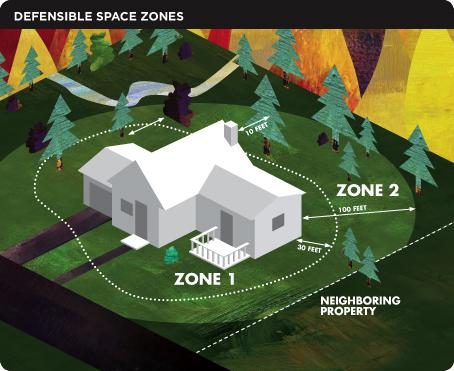(We’re re-running this article to remind everyone about what we can do to prevent fires in our neighborhood.)
Huge thanks to our local RR Fire Protection District Firefighters, Cal Fire (i.e. CDF) and Fire Safe Sonoma, especially to Caerleon Safford (FSS) and Marshall Turbeville (CalFire)!
Following are some of the important points from a presentation and discussion with the three above agencies, who so generously attended a Friends of Rio Nido membership meeting. Please consider this information for your beneficial use, as appropriate for your residence in Rio Nido.
- Fire travels up steep slopes more than 5 times faster than downhill. Thus, for people living on a slope, particular consideration should be given to “fuel sources” that lie downhill.
- Although almost anything can be a “fuel source,” some primary examples of items that should be avoided or trimmed back to be more than 10 feet from your house: dead vegetation or trees, overhanging tree limbs, a collection of ornamental grasses/berries (e.g. junipers) since they are highly flammable, collected garbage and papers. For firewood piles, the distance should be greater (ideally >30 feet). Also related – gutter debris, brooms, and wood furniture prone to burning. And though ivy can hold moisture, it also can hide dead vegetation and kills its host tree.
- “Defensible Space” around your house is a critical aspect of reducing the probability of a nearby fire affecting to your house. This includes trimming plants and small trees around your home to avoid “ladder fuel”: vegetation that allows a fire to travel from lower plants, to increasingly taller ones and ultimately treetops (which is when it can cover vastly greater distances).
- In the case of an emergency: (1) Having your house clearly marked with reflective numbers is critical in the case of an emergency. Our local firefighters sell these signs for $15. Call 869-0553 to order. (2) Have an evacuation plan, ideally with two possible means out of your house and neighborhood.
- Note that dead/dried wood is especially problematic because it is much more prone to creating problematic embers than living trees.
Excellent information sources are abundant! Check these out for starters:
- Cal Fire’s explanation of Defensible Space and Homeowner’s Checklist (both excellent!)
- Fire Safe Sonoma’s Living with Fire in Sonoma County (excellent!)
- FEMA’s plan & prepare website, and FEMA information on what to do before & in case of a fire
- Disaster preparedness information from our Russian River District

